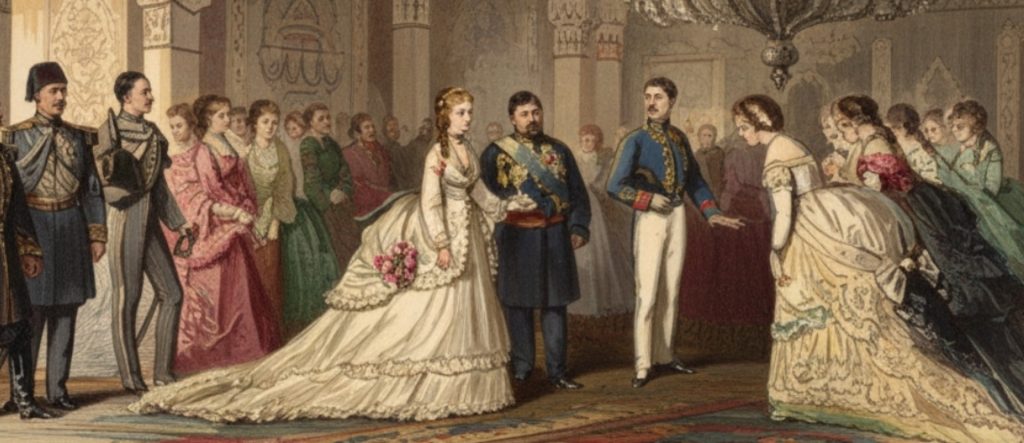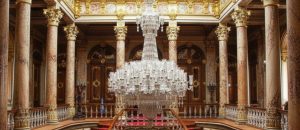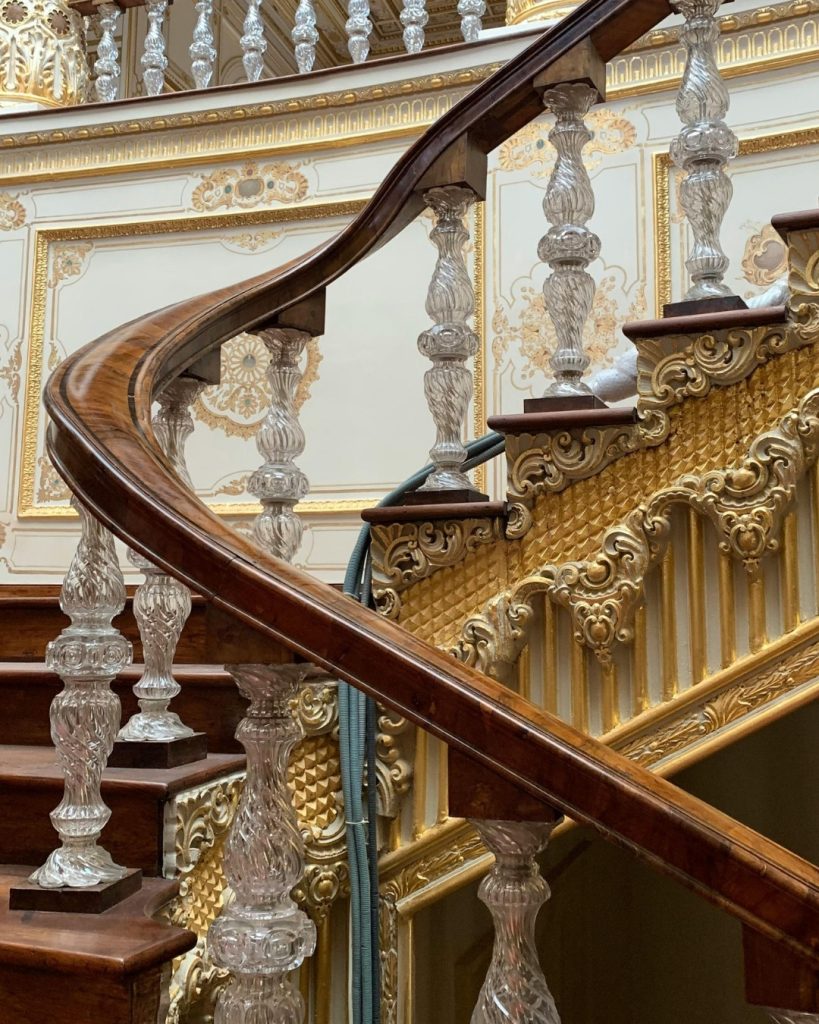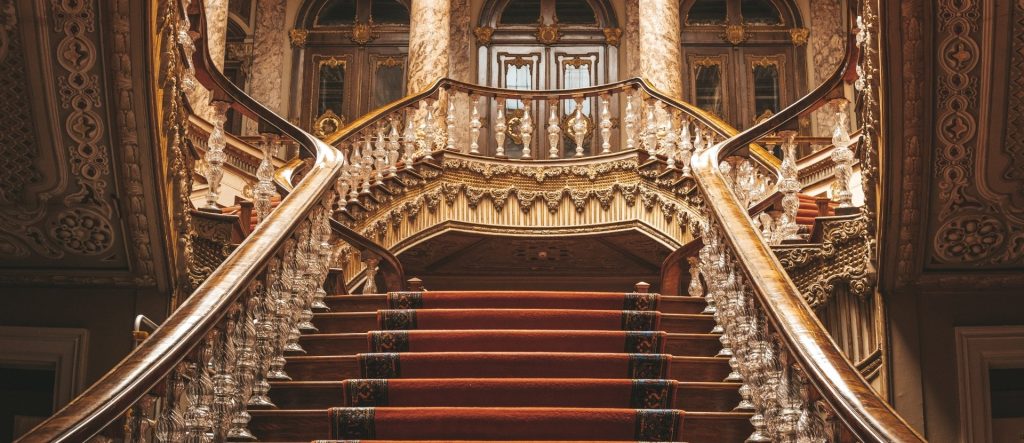The Ceremonial Splendor
Welcome to the Selamlık, the stage upon which the Ottoman Empire performed its final act of grandeur.
This is not a mere collection of rooms, but a meticulously designed sequence of spaces created to awe, inspire, and declare the Sultan’s undiminished authority to the world. From the moment of entry, every detail—from the glistening crystal to the vast, echoing halls—was a deliberate instrument of statecraft and diplomacy.
The Emperor's Stage
A state visit to Dolmabahçe was the ultimate diplomatic theater, a meticulously choreographed ballet of power and prestige. From the moment an ambassador’s ship entered the Bosphorus to their final bow before the Sultan, every detail was a message.
Discover the unwritten rules and imperial protocols that governed these high-stakes encounters.

Ambassadors and Emperors: How Did a State Visit Protocol Work in Dolmabahçe Palace?

Anatomy of Splendor: A Vocabulary of Power
A fool sees only gold and crystal. The wise see a vocabulary of power. Here, we dissect the elements of the masterpiece.
Discover the story behind every Baccarat chandelier whispering of diplomacy, every inlaid parquet floor mapping the Empire’s reach, and every ornate gate declaring its impenetrable majesty.

Ballroom Instead of Sini (Tray/Serving Table): How Dolmabahçe Architecture Transformed Centuries-Old Palace Ceremonies?

The Crystals of Diplomacy: Dolmabahçe’s Chandelier Collection and Glittering Messages

From Marble to Egypt: The Imperial Journey of the Materials that Built Dolmabahçe
Enrich Your Exploration

Medicana: A Legacy of Health

Avis: The Keys to the City
The Grand Ascent: The Crystal Staircase
A Stairway to Imperial Majesty
This is not merely a staircase; it is the overture to the symphony of Dolmabahçe. Commissioned by Sultan Abdülmecid and crafted by the legendary house of Baccarat, its balusters are made of solid crystal, shimmering under the light that floods from the dome above.
The double-horseshoe design was an engineering marvel, creating a sense of boundless space and theatrical grandeur. To ascend these stairs was the first part of the diplomatic ritual; a deliberate act of psychological elevation designed to humble and awe every visitor, preparing them for their audience with the Sultan. It is a cascade of frozen light, a path to the heavens built within the heart of the palace.

The Instruments of Splendor: Five Pillars of Imperial Design
Gilded Gold & Stucco
The ceilings of Dolmabahçe were not merely decorated; they were drenched in the language of pure opulence. An estimated fourteen tons of gold were painstakingly applied as gold leaf by masters, creating a celestial shimmer throughout the ceremonial halls.
This breathtaking gilding was complemented by intricate stucco work—ornate plaster reliefs crafted by Italian artisans invited to the capital. This fusion of Ottoman gold and European stucco created an interior that was both overwhelmingly rich and exquisitely detailed.
Hereke Imperial Carpets
The floors of Dolmabahçe were stages for displaying another form of imperial might: the Hereke carpet. The Hereke Imperial Factory was established specifically to furnish the palace with the finest silk carpets in the world.
These immense, hand-woven masterpieces, some of the largest ever made, were more than floor coverings; they were diplomatic statements. Their intricate patterns and vibrant colors were a silent declaration of the empire’s wealth and the unparalleled skill of its artisans.
Bohemian Crystal & Baccarat
The palace reveals an imperial passion for crystal that went far beyond mere chandeliers. This symbol of 19th-century luxury, imported from the famed workshops of Baccarat in France and across Bohemia, was used everywhere: in the magnificent balustrades of the main staircase, as opulent fireplace guards, and in countless candelabras.
Each piece was a prism, designed to capture and refract light, filling the vast halls with a dazzling, almost ethereal glow, signifying a modern and transparent monarchy.
Sèvres Porcelain & Diplomatic Gifts
The grand halls of the Selamlık also served as a gallery for trophies of diplomacy. Foremost among these are the monumental Sèvres porcelain vases, many of which were personal gifts from foreign rulers like French Emperor Napoleon III.
These priceless pieces from the famous French manufactory were not just decorative objects; they were strategic assets, symbols of political alliances and mutual respect exchanged between the great powers of the era.
European-Style Furniture
The era of sitting on floor cushions and divans, a hallmark of Topkapı Palace, was over. The furniture of Dolmabahçe represents a revolution in courtly life, designed to accommodate a new, formal European protocol.
Gilded armchairs from Paris, elegant consoles from Vienna, and grand dining tables replaced the traditional Ottoman seating. This was not just a change in taste; it was a conscious decision to adopt the physical language of Western monarchies, shaping a new way of living, receiving, and ruling.
Faces of Power & Diplomacy: The Protagonists of the Palace
Where the Empire Met the World
The Ambassador's Hall (Süfera Salonu)
The magnificent chamber where foreign envoys were received, its gilded decorations and immense Hereke carpet designed to project imperial wealth and leave no doubt as to the grandeur of the Ottoman court.
The Red Room (Zülvecheyn Salonu)
The magnificent chamber where foreign envoys were received, its gilded decorations and immense Hereke carpet designed to project imperial wealth and leave no doubt as to the grandeur of the Ottoman court.
The Main Secretariat Hall
The administrative heart of the palace, where the grand bureaucracy of a modernizing empire was managed. This was the engine room of the Tanzimat reforms, lined with desks for the scribes and clerks who ran the state.

The Ceremonial Hall

The Heartbeat of the Empire
All corridors and staircases of Dolmabahçe lead to this single, breathtaking space. The Ceremonial Hall is the architectural and spiritual climax of the palace, a testament to its imperial ambition. Its 56 columns vanish into the background, allowing the immense dome to float weightlessly, creating a vast, uninterrupted volume of space.
From this dome hangs the world’s largest Bohemian crystal chandelier—a gift from Queen Victoria, weighing 4.5 tons and holding 750 lamps. It was here, under its dazzling light, that the empire’s most sacred state ceremonies, from accession to the throne to religious holiday receptions, took place. It was not just a room; it was the empire’s grandest stage.
Where the Palace Meets the Palate
Lacivert: The Bosphorus, Reimagined for Your Palate
You’ve witnessed the imperial grandeur from within the palace walls.
Now, experience its reflection across the water. At Lacivert, the timeless silhouette of Istanbul meets the vibrant flavors of the Mediterranean, creating a memory worthy of the view.
Frequently Asked Questionsabout Dolmabahçe Palace Ceremonial Splendor
What was the main purpose of the Selamlık section?
The Selamlık was the official and public part of Dolmabahçe Palace, designed exclusively for the Sultan’s state functions. It was here that he managed the empire, received ambassadors, and held grand ceremonies, completely separate from his private family life in the Harem.
Is the Crystal Staircase really made of crystal?
Yes. The magnificent balusters of the staircase are crafted from solid Baccarat crystal, while the handrail is made of brass. It was an extravagant statement of modernity and wealth, designed to be the breathtaking first impression for any visitor entering the palace’s ceremonial heart.
What is the story of the great chandelier in the Ceremonial Hall?
The massive chandelier is the largest Bohemian crystal chandelier in the world, a diplomatic gift from Queen Victoria of Great Britain. Weighing 4.5 tons and holding 750 lamps, its installation was an engineering feat and symbolized the close political and cultural ties between the Ottoman and British Empires in the 19th century.
What kind of events took place in the Ceremonial Hall (Muayede Salonu)?
This was the empire’s grandest stage. It was used for the most important state ceremonies, including the Sultan’s accession to the throne (Cülus), religious holiday receptions where the Sultan would receive state officials, and formal banquets for visiting heads of state.
Why does this part of the palace look so European?
The Selamlık’s design was a deliberate political statement. By adopting lavish European styles like Baroque and Neoclassical, the Ottoman Sultanate aimed to present itself as a modern, sophisticated, and equal power on the world stage, moving away from the more traditional, introverted style of Topkapı Palace.
Who was received in the Ambassador's Hall (Süfera Salonu)?
This was the primary hall for diplomacy. Ambassadors from foreign nations would be brought here for their formal audiences with the Sultan or the Grand Vizier. The hall’s opulent gold decorations and massive Hereke carpet were designed to impress and overwhelm foreign dignitaries.
Could an ordinary person enter the Selamlık during the Ottoman era?
Absolutely not. Access to the Selamlık was strictly controlled and limited to high-ranking state officials, the palace bureaucracy, and accredited foreign diplomats. To be granted entry was a sign of immense privilege and proximity to imperial power.







